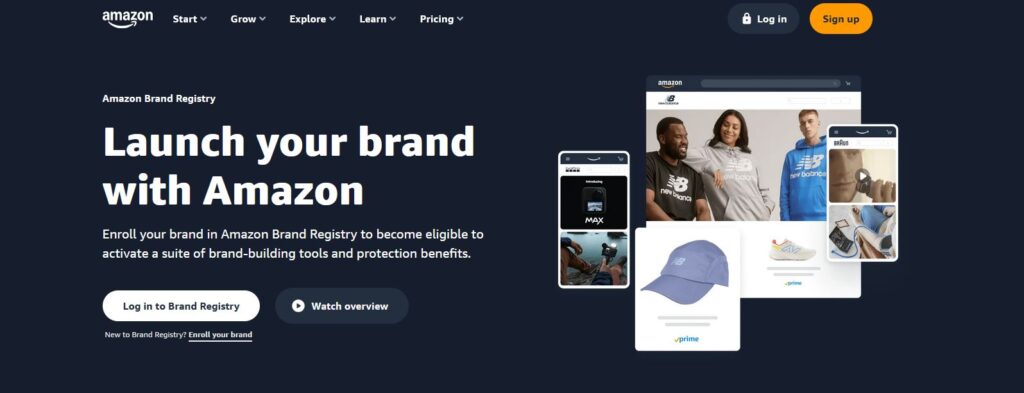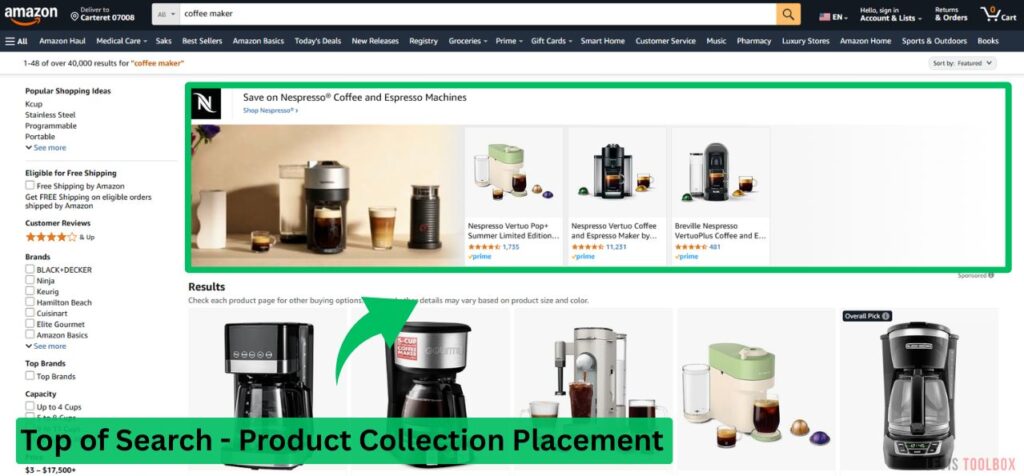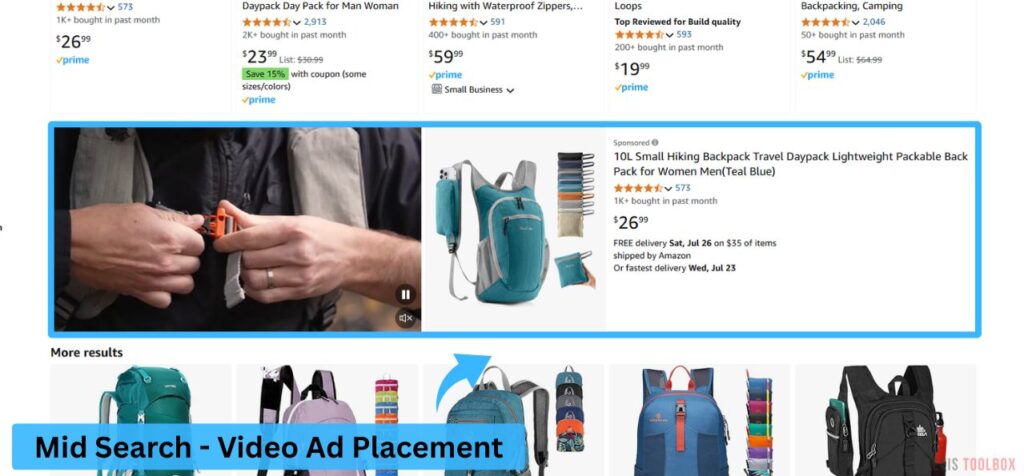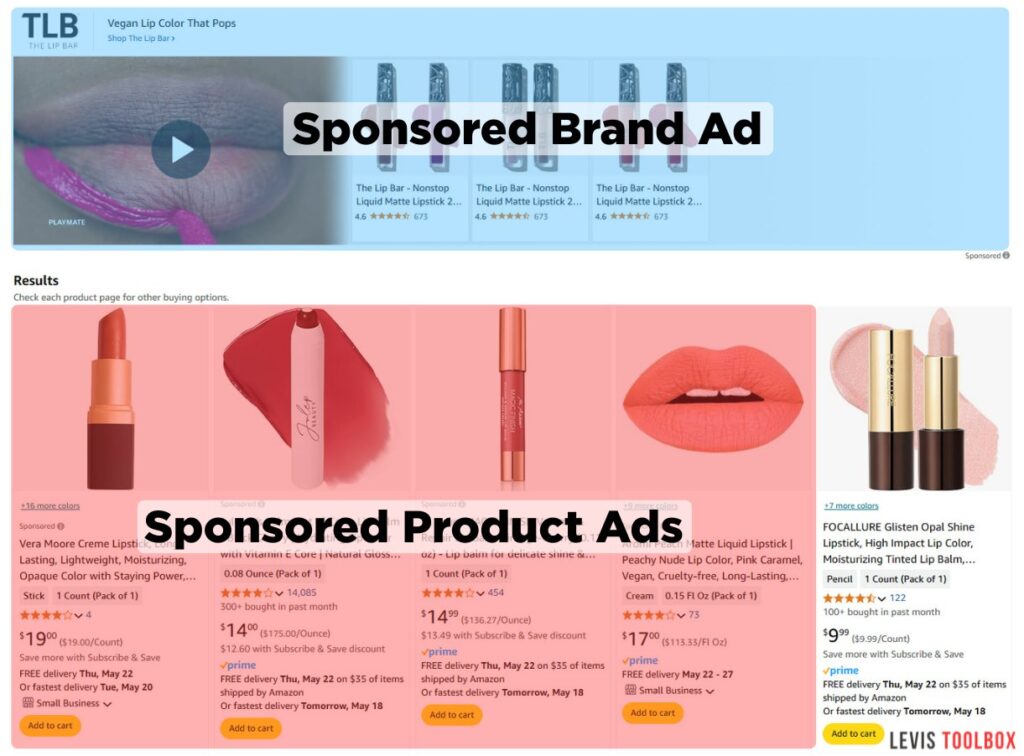Sponsored Brands ads are Amazon’s best tool for sellers who want to promote more than just a single product. Unlike Sponsored Products, Sponsored Brands lets you showcase your entire brand by displaying your logo, custom creatives, and multiple products right at the top of Amazon’s search results.
I’ve been managing Sponsored Brands campaigns since Amazon first introduced them in 2017. In that time, I’ve learned that the best-performing campaigns always come down to three things: a strong creative, well-researched keyword or product targeting, and a high-converting landing page.
In this guide, I’ll walk you step-by-step through how Sponsored Brands work, break down the key ad formats, and share tips on setting up campaigns that drive real clicks and sales. By the end, you’ll know exactly how to use these ads to increase your sales and build long-term brand loyalty on Amazon.
What Are Amazon Sponsored Brands?
Amazon Sponsored Brands, previously known as Headline Search Ads, are a type of ad that lets you promote your brand, not just a single product. Instead of pushing one listing, Sponsored Brand ads give you a chance to tell a bigger story. Some formats let you feature a video, others promote a few of your products, and some send shoppers straight to your Brand Store to explore different categories. The goal is to get more eyeballs on your brand and guide shoppers deeper into your product catalog.

You’ve probably seen these ads before: a video of someone using a product mid-scroll, or a banner showing multiple items from the same brand. That’s a Sponsored Brand ad in action. They’re pay-per-click, just like Sponsored Products, but with additional features like custom creatives and unique landing pages.
Who Can Use Sponsored Brands Ads?

To run Sponsored Brands ads, you’ll need two things: a Professional Seller account (which is a requirement for any form of Amazon Advertising) and enrollment in the Amazon Brand Registry.
The Brand Registry is what officially identifies you as the brand owner on Amazon. It gives you more control over your listings, access to A+ Content, a Brand Store, and, most importantly for our purposes, it unlocks the Sponsored Brands campaign type. Signing up for the registry is completely free, but you will need an active or pending trademark to apply.
In my opinion, if you already have, or are planning to create a private label brand on Amazon, there’s really no reason not to enroll. The Brand Registry gives you access to better ads, better analytics, and several tools to help protect your products and your business. If you’re not sure how to get started, here’s my step-by-step guide to Brand Registry on Amazon.
How Do Sponsored Brands Ads Work on Amazon?
When a shopper enters a search term into Amazon’s search bar, it instantly triggers a real-time ad auction. During this auction, Amazon looks at all the eligible Sponsored Brands ads targeting that keyword. Then, based on several factors like the bid, past ad performance, keyword alignment, and product relevance, the algorithm determines which ads earn placements.

There are several placement options for Sponsored Brands, so the winning ads may show at the top of search results, mid search, or on product pages. From there, what happens next depends on the ad type you’re running. With Sponsored Brands, clicking your ad might take shoppers directly to a specific product detail page, your Storefront, or a custom landing page you created.

The entire process, from keyword entry to ad click, happens in milliseconds. But Amazon’s algorithm is continually learning, meaning relevance, a quality creative, and good keyword research remain just as important as your bids for getting the right placements consistently.
Amazon Sponsored Brands Ad Formats Explained
Sponsored Brands ads come in three formats: Product Collection, Store Spotlight, and Sponsored Brands Video. Each serves a different purpose depending on your goals, catalog size, and the creative assets you have available. Below, we’ll break down each one, and I’ll share a few recommendations based on what’s working in 2025.
| Category | Product Collection | Store Spotlight | Video |
|---|---|---|---|
| Best Use Case | Bundling related products or showcasing similar ASINs in one ad. Great for upsells, product launches, and cross-promotion. | Driving traffic to different categories in your Brand Store. | Showing how your product works to shoppers. Ideal for tools, gadgets, or anything that benefits from a product demonstration. |
| Creative Requirements | Custom headline, brand logo, lifestyle image, and at least 3 products. | Headline, logo, and 3 Store subpages; minimal visual customization. | 6–45 sec product video that auto-plays on mute. |
| Landing Page Options | Clicks can go to a product page, custom landing page, or your Brand Store. | All clicks direct shoppers to your Storefront or a specific subpage. | Can lead to your Store or directly to a product page. |
| Placements | Top of search, product pages, and bottom of search. | Top of search, same as Product Collection Ads. | Top of search (when using your Brand Store as a landing page), mid-search placements, and product detail pages. |
| Good Fit For | Sellers with multiple products in the same category. Great for boosting underperforming ASINs by pairing them with top sellers. | Brands with an optimized Brand Store and a large range of products. | Sellers with a solid product video or brands that can produce video content. |
Product Collection Ads
Product Collection ads are still my go-to for driving steady results, especially if you’re launching new products or offer several similar or complementary products. These ads display your brand logo, a custom headline, and up to three clickable products in a banner-style ad. The ads have several potential placements, including at the top and bottom of search results, on product detail pages, and in the sidebar.
Shoppers who click on a product go directly to the listing, while clicks on the image, headline, or logo can lead to your BrandStore or a custom landing page, whichever makes the most sense for your business.

With these ads, it’s important to choose the right mix of products. Always start with a top seller in the first slot since, statistically speaking, it’s going to draw the most attention. I like to pair that with newer ASINs that need a sales boost or complementary products that may lead to larger AOV’s (average order values). Just remember, if one item goes out of stock, the ad will stop running, so make sure you have healthy inventory levels for each product you choose.
Your ad creative also plays a huge role. In 2024, Amazon made including a lifestyle image a requirement for this ad format, and honestly, that’s a good thing. The right photo, which shows your product in use, can significantly improve your click-through rate. Avoid cluttered shots or generic white-backgrounds and instead choose images that display the main benefits of your product. And make sure it’s optimized for mobile. With the majority of Amazon shoppers using their phones for shopping, try to avoid wide shots and instead choose images that clearly show off your product, even on smaller screens.
Store Spotlight Ads
Store Spotlight ads let you feature up to three subpages from your Amazon Store instead of individual products. It’s a format that works best for brands with a large selection of products and a well-built Brand Store with multiple categories like “Protein,” “Amino Acids,” or “Preworkout.”

I’ve tested this format a few times, and honestly, the results have been mixed. The concept is solid, but I’ve found it harder to get good results compared to Product Collection or Video ads. Since the ad doesn’t show product reviews or Prime badges, it just doesn’t pop the same way in search results. That said, if you’ve invested in your Storefront and have a wide product range, they might be worth experimenting with. Since this ad format is so rare on the platform, there is a chance that this ad type is simply underrated.
The key is to treat these ads as a top-of-funnel tool. A Store Spotlight Ad won’t convert as directly, but it can help shoppers explore more of your brand, especially if your Store is set up well. If you try it, rotate subpages, test different images, and use Store Insights to see what shoppers actually click on.
Sponsored Brands Video Ads
If you’re looking for an ad format that actually stops shoppers mid-scroll, this is the one. Sponsored Brands video ads autoplay in search results and can link directly to your product detail page or your Amazon Storefront. The format works especially well for products that need a demonstration or have a “wow factor”, something with an interesting visual feature, or a story to tell.

In my experience, these ads consistently outperform static formats in both click-through rate and conversion. They stand out on an otherwise static page and give you a chance to pre-sell the product before the shopper even clicks on it.
Obviously, the most important part of a video ad is the video, and the first five seconds are key. Show the product right away, highlight how it works or what problem it solves, and keep the video short; under 30 seconds is ideal. You don’t need a “slick” marketing style video either. Some of my best-performing videos were shot on my old iPhone, just showing the product being used with a few, clean cuts and minimal editing. Authenticity matters more than polish here. And since most shoppers scroll with sound off, the video has to make sense without audio.

If you have a product video or have the capabilities of making one, I highly encourage you to test this ad type. For any product that benefits from a demo or needs help standing out in a highly competitive niche, this is one of the best ad formats available. It takes a bit more effort to create, but the payoff is usually worth it.
Sponsored Brands vs. Sponsored Products
Sponsored Product ads are the foundation of any Amazon Ads account. They promote a single ASIN using your existing title and image, and they show up where shoppers are already ready to buy. Because they have the most placements and the lowest CPCs, they’re perfect for product launches, improving your organic rankings, and driving consistent sales.
Sponsored Brands, on the other hand, offer more control, both in how your brand appears and where shoppers land after they click. And while CPCs are typically higher, you’re getting high-converting, premium placements in exchange for that extra cost. If you’re working with a strong creative and a well-structured Brand Store, those extra costs are more than worth it.
| Feature | Sponsored Product Ads | Sponsored Brand Ads |
|---|---|---|
| Purpose | Promote individual products to shoppers ready to buy | Highlight your brand and multiple products to shoppers |
| Placement | Ads appear in multiple locations within search results and product detail pages. | Placements depend on ad format. Ads can appear in search results and on product detail pages. |
| Creative Format | Uses your existing product listing. No customization options. | Custom headline, logo, lifestyle image or video, and up to 3 products or Brand Store pages |
| Cost-Per-Click (CPC) | Generally lower CPCs. More placements available | Higher CPCs due to premium placements and limited ad inventory |
| Eligibility | Requires a Professional Seller Account | Requires enrollment in the Brand Registry and a Professional Seller Account |
| Setup Difficulty | Quick to launch. No custom creative required. | More work. Requires a custom creative, either image or video. |
| Landing Page | Sends shoppers to your product detail page. | Lets you choose the landing page (Store, product page, or custom page). |
It’s important not to look at this as an either-or. When a customer sees your video, then your sponsored product listing later in the search results, you get more impressions, more clicks, and a stronger path to conversion.
I usually allocate 70–90% of my ad budget to Sponsored Products, but I always run both. Even a small, well-targeted Sponsored Brand campaign can be enough to move the needle.

Sponsored Brands Launch Checklist: 6 Steps for a Strong Start
Launching your first Sponsored Brands campaign doesn’t need to be stressful. I’ve narrowed down six critical steps I always double-check to avoid mistakes, minimize wasted spend, and maximize early success.
- Is Your Landing Page Fully Optimized?
Even if you create the greatest advertisement in the world, your campaign will struggle if you’re sending traffic to an unoptimized landing page. Before launching, double-check your product detail pages. Make sure they have clear titles, benefit-focused bullet points, high-quality images, and an optimized A+ Content section. If your ads link to your Store, take the time to make sure it’s easy to navigate and that the products listed in your ad are clearly visible on your Storefront. - Did You Choose the Right Selection of Products?
If you’re using Product Collection ads, don’t just choose a random selection of three products. Each ad should feature products that naturally fit together. Keep it targeted. If shoppers search for “sofa,” don’t distract them by adding dining tables into the same ad. Stick to complementary products and try to focus on products with a minimum of 15 reviews and at least a 4-star rating. If you want to include a new product, pair it with a best seller to boost the credibility and social proof of your ad. - Did You Create An Optimized Keyword List?
When it comes to both listing optimization and ad campaigns, your keyword list and keyword targeting are king. Make sure you’ve taken the time to create a fully optimized keyword list with tools like Helium 10, Jungle Scout, or the Product Opportunity Explorer. Use at least 25 relevant keywords in broad, phrase, and exact match types. Separate branded terms (your brand and product names) from generic keywords into separate campaigns for better control. - Did You Set a Realistic Budget?
Before you launch your campaign, consider your budget both at the campaign level and as part of your advertising budget as a whole. Sponsored Brands are an important part of your ad strategy, but Sponsored Products are still the backbone. For this reason, I typically recommend keeping them at around 10 – 20% of your total ad spend. At a campaign level, I recommend a minimum budget of around $50 a day, but you need to find what makes the most sense for your business and financial situation. - Do You Have a Compelling Ad Creative?
Your ad only has seconds to grab a shopper’s attention before they scroll by. Take the time to double-check that your lifestyle image shows your product in use, clearly displays a benefit, and properly frames your product. Make sure your headline is tailored for the keywords you’re targeting. Ads that feature the keyword that shoppers are searching for always perform better than those that don’t. For example, if you’re targeting several keywords about “waterproof dog beds”, try to include that keyword in your title. - Is Your Product Video Optimized?
For Sponsored Brand Video ads, keep them brief and compelling, ideally around 15–30 seconds. Focus on clearly demonstrating your product’s unique features right at the start to catch shoppers’ attention. Use captions or text overlays for silent viewing, and avoid unnecessary intros or filler scenes. Simple, UGC-style videos often outperform flashy, complicated ones.
How to Optimize Amazon Sponsored Brands Campaigns for Better Results
Getting the most from your Sponsored Brands campaigns means paying close attention to how your ads are built, targeted, and managed over time. While many sellers set up campaigns and hope for the best, getting the most out of your ad budget depends on a few important habits.
- Review your search term performance regularly: It’s important to analyze your search term reports weekly. Look for phrases or terms that are driving the most clicks and conversions, and consider removing or pausing any keywords with low CTR’s, conversions, and high CPC’s. When you find high-performing keywords, consider “harvesting” them and adding them to a new campaign as exact match keywords.
- Update Your Negative Keyword List Regularly: A second use for the Search Term report is finding new negative keywords to add to your campaign. Look for keywords with a high amount of clicks but very few conversions; these are great candidates for your negative keyword list. Make it a habit of regularly updating your negative keywords in order to reduce wasted ad spend and further improve your campaign’s performance
- Match Shopper Intent: If your headline promotes eco-friendly storage bins, your landing page should highlight exactly that, not a general catalog of all of your products. Relevance is key to converting clicks into sales. If you’re having trouble coming up with good headlines, AI tools like ChatGPT or Claude can be great resources for brainstorming ideas. Ask the AI to come up with 10-20 possible headline ideas and then pick the best one.
- Always A/B Test Your Ads: The name of the game with advertising is to always be testing. When it comes to Sponsored Brands, there are a lot of moving parts, but the three I recommend testing the most are your headline, your creative, and your landing page. Just remember to only test one change at a time in order to get clear feedback and to avoid muddying the results.
- Keep a Close Eye on Your Metrics: This might be an obvious one, but your RoAS and ACoS give you a direct line into how your campaigns are really performing. Thousands of sellers are constantly launching new campaigns, tweaking bids, and testing keywords. Just because a bid was performing last week doesn’t mean it’ll hold up today. If you want to stay profitable, you’ve got to stay on top of your metrics and be ready to adjust your bids, budgets, or targeting when necessary. Check out our Free Amazon Ads Calculator to quickly determine your current ACoS, suggested starting bids, and more.

Frequently Asked Questions (FAQs)
What are Sponsored Brands on Amazon?
Sponsored Brands are a type of Amazon PPC ad that allows brand-registered sellers to promote more than just one product. Unlike Sponsored Products, which focus on individual listings, Sponsored Brands give you the flexibility to showcase multiple items, use custom creatives like videos and lifestyle images, and send shoppers to either your Brand Store or a custom landing page.
They’re ideal for building brand awareness, telling your brand story, and helping customers explore your full product line, all directly from the search results.
How much should I budget for Amazon Sponsored Brands?
There’s no strict minimum required to run Sponsored Brands ads, but your daily budget plays a big role in how well your campaign performs. Amazon recommends choosing a budget that allows your ads to run consistently throughout the day. If your budget is too low, especially under $5 per day, it can be difficult to generate enough impressions or clicks to see results.
As a general starting point, I recommend budgeting around $50 per day when launching a new campaign. This gives your ad enough room to collect data, reach your target audience, and see what’s working. Just make sure the spend fits within your overall marketing budget. You can always scale up or down as you get more results and optimize your campaign.
Can I run Sponsored Brand ads without a Brand Store?
No, you don’t need a Brand Store to run Sponsored Brand Ads. When setting up your campaign, you’ll have two options for the landing page: you can either link to your Amazon Storefront or let Amazon generate a custom landing page featuring a selection of products you choose.
If you don’t have a Brand Store yet, or if your store isn’t finished, updated, or optimized for conversions, you can always choose the custom landing page option. This way, you can still run successful Brand campaigns even without a Brand Store.
What types of creatives perform best for Sponsored Brand Ads?
Video ads generally perform best for Sponsored Brand campaigns, especially high-quality product demonstration videos or user-generated content (UGC). Product Collection ads using lifestyle images can also work well.
UGC-style videos, especially videos featuring a real person using and talking about your product, are incredibly powerful. These types of videos often feel more trustworthy and relatable to shoppers, and they frequently outperform slick, expensive marketing-style content.
What are the image and video requirements for Amazon Sponsored Brands ads?
For video ads, Amazon recommends keeping the length between 6 and 45 seconds, formatted at 16:9 with a resolution of at least 1280 × 720 pixels. Files must be under 500 MB and submitted as MP4 or MOV. Avoid letterboxing or pillarboxing, and make sure your video communicates clearly without sound. Sponsored Brands video ads play on mute by default, so use captions or on-screen text to highlight important points.
For image creatives (like Product Collection or Store Spotlight), upload three aspect ratios: wide (1200 × 628), square (1200 × 1200), and tall (900 × 1600). Each file should be under 5 MB, with no overlaid text, logos, or buttons.
For full details, I recommend checking Amazon’s latest ad specs here:
https://advertising.amazon.com/resources/ad-specs
Making Sponsored Brands Part of Your Amazon Ads Strategy
If you’ve already found success with Sponsored Products campaigns and you’re looking to expand, this is your next step. It’s one of the few Amazon ad types that actually lets you shape how shoppers experience your brand, from headline to landing page.
In my own campaigns, I’ve used Sponsored Brands to launch new product lines, push seasonal promotions, and drive more traffic to my Brand Stores. And my hope is that after reading this article, you will too. If you’re building a real brand on Amazon, Sponsored Brands needs to be part of your playbook.
Recommended Articles
- Brand Registry on Amazon: A Comprehensive Guide for 2025
- 7 Best Amazon PPC Tools Every Seller Should Know in 2025
- What is Amazon PPC? A Beginner’s Guide to Amazon Advertising
Levi Adler is an experienced Amazon seller, e-commerce specialist, and the founder of Levi’s Toolbox. With over a decade in the trenches selling on Amazon and managing his own Shopify stores, Levi writes from his own experience. Sharing what worked, what flopped, and the strategies he wishes he’d known sooner. When he’s optimizing listings or managing ad campaigns, you’ll find Levi hitting mountain bike trails or hanging out with his two huskies, Emma and Scout.
